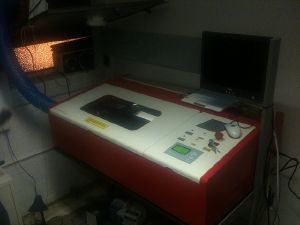Equipment/HPC LS3060 Laser Cutter: Difference between revisions
From London Hackspace Wiki
| Line 65: | Line 65: | ||
====Positioning your material==== | ====Positioning your material==== | ||
'''TODO''' | '''TODO''' | ||
* Caution - | * '''Caution:''' Know your material - be absolutely certain that your material is safe to use in the laser cutter. If in doubt - ask. | ||
* Caution | * '''Caution:''' There are a number of electrically live areas inside the cabinet towards the back. Be very careful when reaching around there as you may get a shock. | ||
* Setting the bed Z-axis | * Setting the bed Z-axis | ||
* Viewing the bounding box with red-dot pointer | * Viewing the bounding box with red-dot pointer | ||
Revision as of 11:40, 15 September 2010
Logbook
15/09/2010 Operator Russ
- Cut some 1.5mm neoprene fairly successfully - needs high power and it's a bit smelly. (Settings in the book.)
- Circle issue is fixed. It was a problem with the tension on the frontmost X drive belt.
- Did some awesome etching onto black anodised aluminium - 450mm/sec, 90% power.
13/09/2010 Operator: samthetechie
Todo: Test CorelDraw X3 with 20mm circles on paper and compare to test using LaserCutter Software
12/09/2010 Operator: samthetechie
- Setup CorelDraw X3 with LaserCutter Add-on Toolbar.
- Cut Mic On Sign 3mm Perspex.
- Cut MusicMetric Sign 6mm MDF.
Model
- HPC LS3060 "plus" laser engraver and cutter.
Specification
| Laser: | 40W - water cooled CO2 laser. |
| Working area: | 320 x 600mm honeycomb bed (cutting area possibly about 300 x 550mm) |
| Features: | Air-assist (removes debris from cutting region),
red-dot pointer (to show beam location) |
| Water cooling: | Simple tube cooling circuit connected with (9mm OD, 6mm ID) latex tube.
Uses supplied submersible pond pump (2.8m head, 2800L/H flow). |
Safety information
Please don't touch or fiddle with the laser cutter unless you've had permission from either Russ or Jonty.
- Please don't affect the cooling system without consultation - overheating or rapid cooling can damage the laser.
- Never leave the laser cutter unattended - Your material may ignite, and an unchecked fire in the laser cutter could be both dangerous and costly.
- In case of fire - Use only the CO2 extinguisher positioned by the cutter.
- Never cut PVC or chlorinated plastic - You should always know what material you are cutting, and chlorinated plastics should be avoided because they release chlorine gas when cut.
- Do not try to cut metal in the laser cutter - If you wish to mark the metal, please use "Thermark Laser Engraving Spray / Paste", or use anodised aluminium.
Instructions
Powering on
TODO
- Pre-checks
- CO2 fire extinguisher to hand
- Water pump
- Extractor fan
- Caution regarding length of use and water temperature.
Uploading your data file
TODO
- Different file types pros/cons
- Setting the scale
- Setting the origin - what to watch out for
- Layers - how are they used
- How do you know when the file is sent successfully
Positioning your material
TODO
- Caution: Know your material - be absolutely certain that your material is safe to use in the laser cutter. If in doubt - ask.
- Caution: There are a number of electrically live areas inside the cabinet towards the back. Be very careful when reaching around there as you may get a shock.
- Setting the bed Z-axis
- Viewing the bounding box with red-dot pointer
Cutting
TODO
- Caution - never leave the machine unattended
- Initiating the cut
- Monitoring progress
- What to watch out for
- What to do in case of problems
- What to try if the result is not what you expect
Parameters for different materials
If you found some sweet settings please share them here.
Cutting
| Material | Thickness (mm) | Speed (mm/sec) | Power (%) | Corner power (%) | Examples |
|---|---|---|---|---|---|
| Ply wood | 3 | ? | ? | ? | some images |
Engraving
| Material | Speed (mm/sec) | Power (%) | Corner power (%) | Examples |
|---|---|---|---|---|
| Anodized aluminium | 450 | 90 | ? | LHS logo on black phone |
Tips
- Some useful laser info from Adafruit - the settings section in particular gave a good idea of what we can expect.
- More information about the controller card used by the cutter
Consumables
- HPC sheet products - Laser ply, perspex, engraving laminate - where we purchased the cutter.
- The Plastics Shop - mattp purchased the plastic for the first batch of Hackspace key rings from here.

